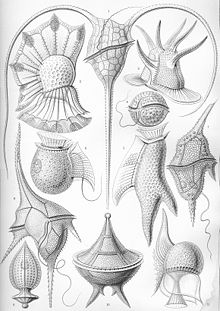- Dinokaryota
-
Dinokaryota 
"Peridinea" from Ernst Haeckel's Kunstformen der Natur, 1904 Scientific classification Domain: Eukaryota Kingdom: Chromalveolata Superphylum: Alveolata Phylum: Dinoflagellata Superclass: Dinokaryota Dinokaryota is the main class of dinoflagellates. They include all species where the nucleus remains a dinokaryon throughout the entire cell cycle, which is typically dominated by the haploid stage. All the "typical" dinoflagellates, such as Peridinium and Gymnodinium, belong here. Others are more unusual, including some that are colonial, amoeboid, or parasitic. Symbiodinium contains the symbiotic zooxanthellae.
The non-photosynthetic members are believed to derive from photosynthetic ancestors.[1]
Contents
Classification
Dinoflagellates are classified by morphology.
With a theca
Species with a theca are divided into four orders, based on the arrangement of the armor plates:
- Peridiniales - e.g. Peridinium
- Gonyaulacales - e.g. Ceratium, Gonyaulax
- Dinophysiales - e.g. Dinophysis
- Prorocentrales - e.g. Prorocentrum
The Peridiniales are probably paraphyletic to the others, and on rRNA trees they are mixed with the species that lack thecae. The other three orders are probably monophyletic, with the Dinophysiales and Prorocentrales as close relatives, united by the presence of a sagittal suture dividing the theca in two.
However, on rRNA trees the Prorocentrales are split up.[2]
Without theca
The groups of dinoflagellates without theca are understood to be artificial, and are mostly polyphyletic. Many of the genera, such as Gymnodinium and Amphidinium, are also polyphyletic. However some may approximate monophyletic groups, such as the Suessiales, and some have not been studied phylogenetically.
- Gymnodiniales - e.g. Gymnodinium, Amphidinium
- Ptychodiscales
- Suessiales - e.g. Symbiodinium
- Desmocapsales
- Phytodiniales (includes Dinococcales, Dinotrichales) - e.g. Dinamoeba, Pfiesteria
- Thoracosphaerales
Blastodiniales
There is also a group of parasitic dinoflagellates, the Blastodiniales, that do not have dinokarya during their trophic stage. Because of this, they have been treated as a separate class Blastodiniphyceae, but some or all may actually have developed within the Dinophyceae.
References
- ^ JF Saldarriaga et al. (2001). "Dinoflagellate Nuclear SSU rRNA Phylogeny Suggests Multiple Plastid Losses and Replacements". Journal of Molecular Evolution 53: 204–213. doi:10.1007/s002390010210. PMID 11523007.
- ^ F. J. R. "Max" Taylor (2004). "Illumination or confusion? Dinoflagellate molecular phylogenetic data viewed from a primarily morphological standpoint". Phycological Research 52: 308–324. doi:10.1111/j.1440-1835.2004.tb00341.x. http://www.ingentaconnect.com/content/bsc/pre/2004/00000052/00000004/art00002.
Ciliophora Spirotrichea (Stylonychia) · Litostomatea (Didinium, Balantidium) · Phyllopharyngea (Tokophrya) · Nassophorea (Nassula) · Colpodea (Colpoda) · Oligohymenophorea (Tetrahymena, Ichthyophthirius, Vorticella, Paramecium) · Plagiopylea (Plagiopyla) · Prostomatea (Coleps)OtherMyzozoa Plasmodiidae/Haemosporida (Plasmodium, Haemoproteus, Leucocytozoon)
Piroplasmida (Babesia, Theileria)Adele-Haemogregarina, Hepatozoon, KaryolysusEimeri-Cryptosporidiidae (Cryptosporidium)
Eimeriidae (Isospora, Cyclospora, Eimeria)
Sarcocystidae (Toxoplasma, Sarcocystis, Besnoitia, Neospora)Agamo-Rhytidocystidae (Rhytidocystis)GregariniaGregarinasina (Gregarina)ColpodellidaeChromeridaChromera velia, Vitrella brassicaformisDinokaryotaWith a theca: Peridiniales (Pfiesteria, Peridinium) · Gonyaulacales (Ceratium, Gonyaulax) · Prorocentrales (Prorocentrum) · Dinophysiales (Dinophysis, Histioneis, Ornithocercus, Oxyphysis)
Without theca: Gymnodiniales (Gymnodinium, Karenia, Karlodinium, Amphidinium) · Suessiales (Polarella, Symbiodinium)
Noctilucales (Noctiluca)Syndiniales: Amoebophryaceae (Amoebophyra) · Duboscquellaceae (Duboscquella) · Syndiniaceae (Hematodinium, Syndinium)OtherRelatedCategories:- Dinoflagellates
Wikimedia Foundation. 2010.
